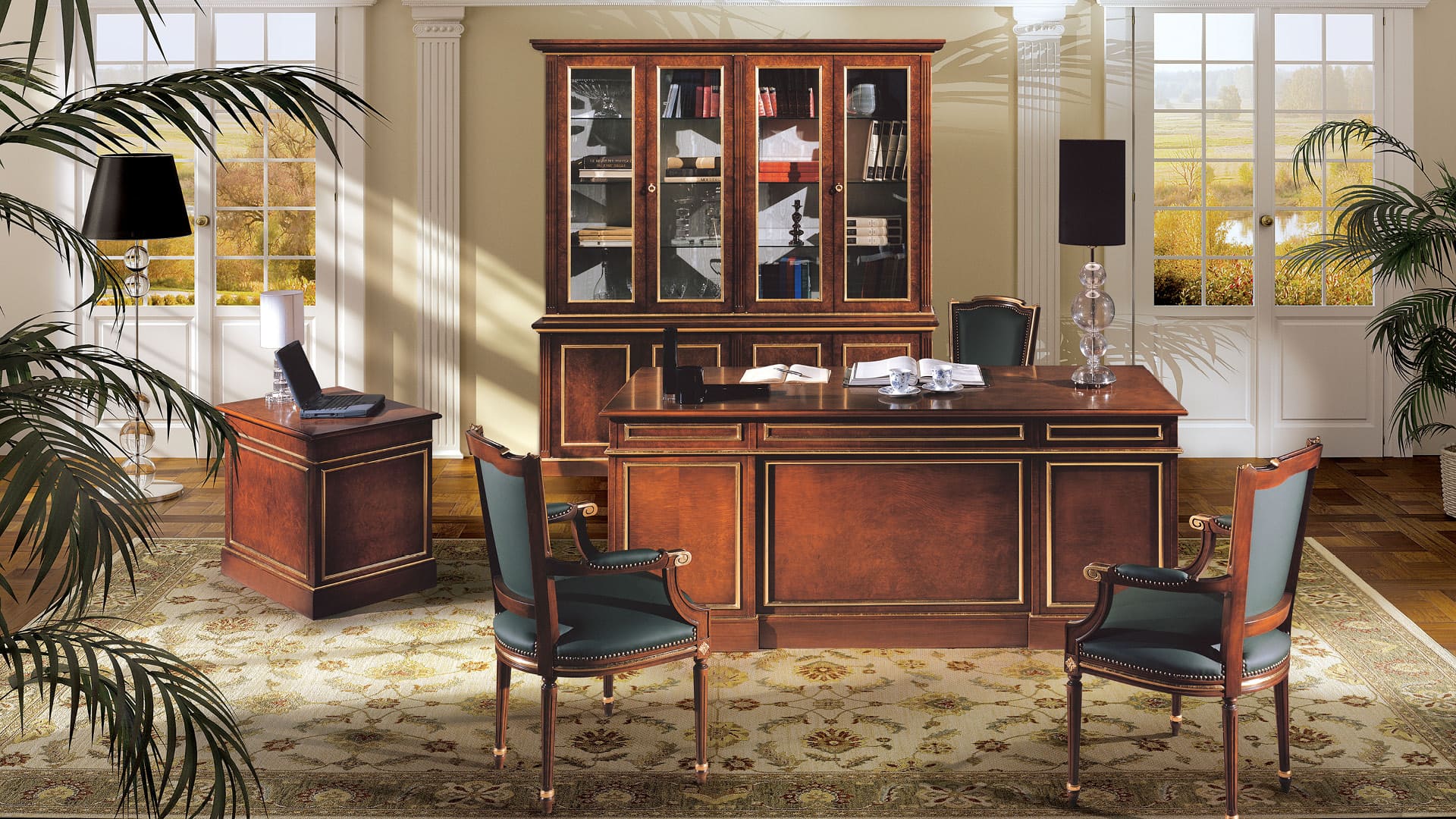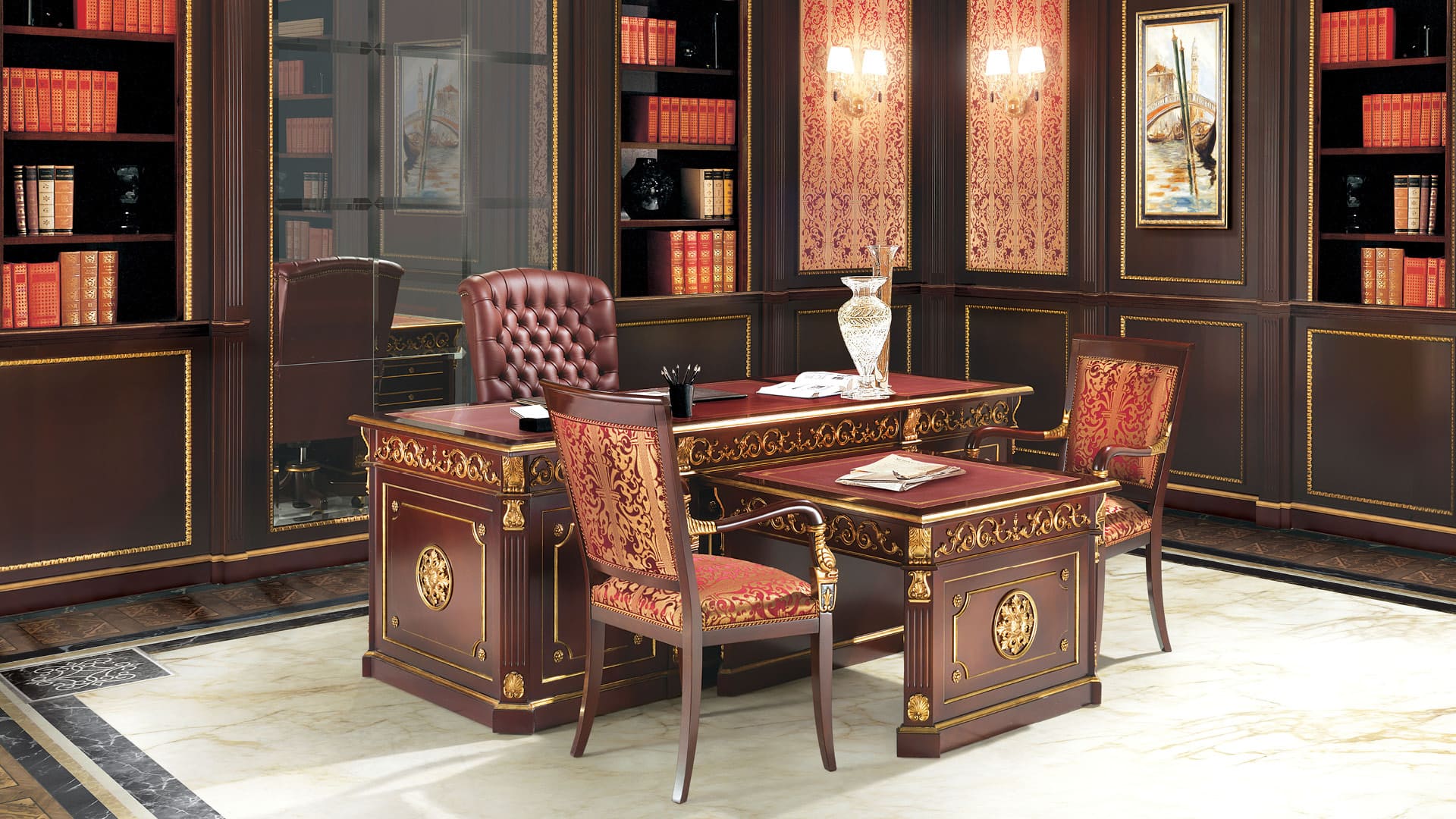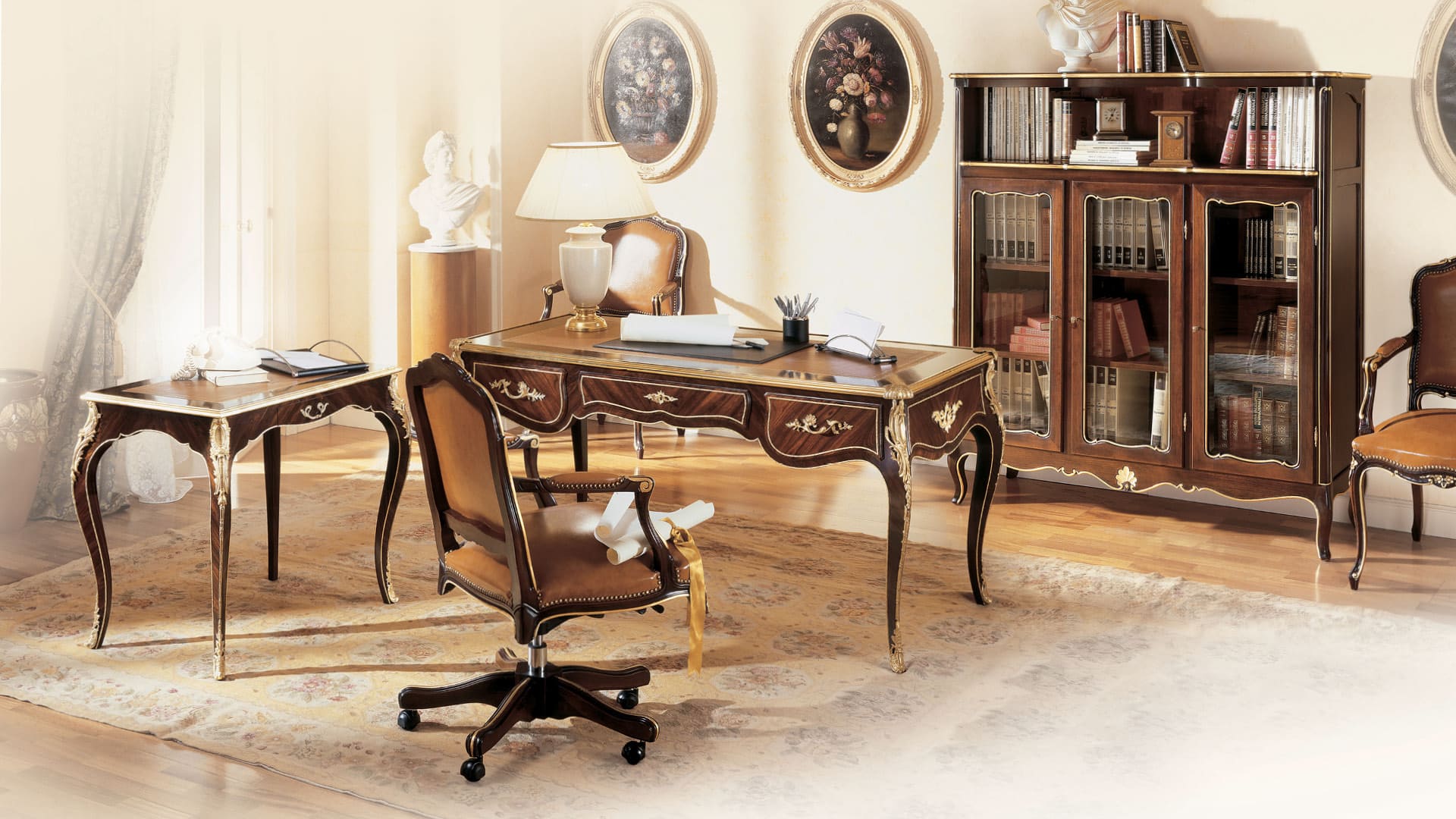
18 Oct Classic furnishing style for your office
How to choose the best classic furnishing style for your office
Office and home office furniture should – just like the décor for every other room in your setting – completely reflect your uniqueness and personal taste. At the same time, it should also embody a flawless synergy between comfort, functionality and design, creating a pleasurable space to work and spend time in.
When it comes to classic furniture, you have many styles you can choose from to get inspired for your perfect office furniture. However, it is essential to truly understand the specific features and peculiarities of each interior design style to discern what solutions are best for you: that is why we always suggest requesting the assistance of a dedicated interior design consultant who, with their experience and expertise, will focus on the furniture elements that genuinely work for your office.
Generally speaking, classic styles exhibit a series of variations according to the specific era the furniture elements are inspired by (classic furniture is, in fact, quite a broad term!). They are predominantly used in the design of executive offices, meeting rooms and halls, where the primary goal is to showcase the company’s solidity and prestige.
Natural wood – often in its darker essences – and leather are the primary materials employed in the manufacturing of classic-style offices, while the overall design of the rooms can be enriched through accents of natural stone, metal and sumptuous textiles like silk.
Preliminary tips to perfectly furnish your office in a classic style
Before choosing every single piece of furniture for your office or home office, and regardless of the classic style you’re attracted to, it is in our opinion essential that you follow a series of rules of thumb that will allow you to proceed smoothly in what is, after all, quite a complex task.
-
- Step One: identify your exact needs and requirements. Before considering the selection of office furniture pieces, compiling a comprehensive inventory of the fundamental requirements for a productive workday is always advisable. This compilation should encompass essential things for an office setting, including a computer, printer, telephone, file storage, and other pertinent equipment. When compiling your inventory, it is crucial to consider the intended utilization of the given area. For instance, individuals engaged in graphic artistry may necessitate the utilization of numerous monitors and an expanded workspace to accommodate their design tools and artistic creations, while consultants may find it necessary to utilize locking file storage cabinets as a means of safeguarding confidential papers. CEOs and managers, on the other hand, will likely have to consider the addition of a lounge space where they can welcome and converse with their guests.
- Step Two: everything has its own place. Whether you’re planning to furnish your corporate office or home office, you will always have to think about how best to use the available space. For example, your desk should face the door or the office entrance while, at the same time, benefit to the max of the natural light in the room. In all cases, offices should be quiet settings conducive to contemplation and meditation, freeing you from distractions and keeping you utterly focused on your tasks.
- Step Three: identify the furniture you need. Of course, every corporate office or home office is structured to provide maximum focus on its key element: the desk. That is hence the piece of furniture you should choose first and most carefully, as it will become the command center of every workday. At the same time, it is essential you identify the key pieces you need in your space: from bookcases to lounge areas, from minibars to side tables, from storage units to lamps and mirrors. In classic-looking offices, prestige and elegance are always key features, and that’s why the setting is rarely sparse. On the contrary, the office embodies an idea of firmness and assertiveness in every element, from statement pieces to accessories. Choose with care.
Angelo Cappellini: the best in class for your classic office furniture
Classical-style office furniture is a commendable option for individuals seeking to operate within a sophisticated and polished workspace and, more generally, is well-suited for professional environments such as corporate offices, headquarters, meeting rooms and executive areas.

Angelo Cappellini, one of the most internationally renowned companies in the design and manufacturing of classic décor for homes and professional spaces, provides a diverse selection of elegant office furniture, encompassing desks, armchairs, bookcases, and cabinets, designed in the most sophisticated and beloved classic styles: Empire, Louis XV and Louis XVI.
Empire-style furniture for your office: grandeur and balance
Empire-style furniture is a neoclassical interior design style characterized by grandeur, symmetry and ornate decorations. Its bold silhouettes translate into furniture pieces showcasing solid and imposing appearances. However, their clean, straight lines – coupled with strong and sturdy volumes – create an overall simplified look compared to other classical styles.
Elegance is, of course, is a must: Empire furniture is typically crafted from luxurious and high-quality materials such as mahogany, rosewood, and walnut. These woods are often embellished with intricate veneers and inlays to further enhance their visual appeal.
The presence of gilded bronze or brass ornaments and decorative elements add a touch of opulence to the pieces, while the sheer attention to detail, enhanced by intricate carvings, column-like legs and ornate molding, creates a grand yet balanced overall appeal.

Angelo Cappellini’s Empire-style furniture for your office is perfectly embodied by the Donatello series, an exquisitely designed working environment that displays the most exclusive elegance and value.
Louis XV-style furniture for your office: the feminine grace of Rococo
Louis XV-style furniture, also known as Rococo furniture, is a triumph of elegance and feminine grace expressed through natural forms. Ornate and graceful designs characterize this interior style and emphasize asymmetry, curves and intricate detailing. Rococo is also famous for its elegant and flowing lines, fully expressed by the curved silhouettes that are present in almost every piece of furniture, together with serpentine fronts and rounded backrests typical of chairs and sofas.
The fluid and organic appearance of Louis XV-style furniture is perfect for decorating an office where elaborate and intricate wood carvings create a sumptuous visual effect while, at the same time, add a sense of delicacy and refinement to the pieces.
While gilding is commonly used in this style, luxurious upholstery also plays a crucial role in the intense elegance of the settings: Louis XV furniture is often upholstered in luxurious fabrics such as silk, damask and brocade, typically adorned with intricate patterns displaying florals. Once again, feminine grace is the keyword for this style, which represents the height of French Rococo design and continues to be admired for its beauty and elegance in the world of furniture design.

Angelo Cappellini’s Louis XV-style furniture for corporate offices and home offices is eloquently expressed through the Borromini series, a perfect combination of refinement and elegance that can be integrated into different contexts, ranging from the most classical to the most contemporary ones.
Louis XVI-style furniture for your office: the sheer simplicity in volumes meets the most refined design
Louis XVI-style furniture emerged in France during the late Eighteenth century, particularly during the reign of King Louis XVI (1774-1792). This style is known for its neoclassical influences and a departure from the elaborate and ornate designs of the preceding Rococo era. Louis XVI-style furniture exhibits a more refined and geometric aesthetic, reflecting the impact of ancient Greek and Roman design: such features make it perfect to design corporate offices or home offices where sobriety and elegance are the key points.
Straight lines and symmetry create a clean appearance in furniture pieces which, unlike the previous Rococo style, are more symmetrical and balanced, reflecting a cultural, historical and stylistic shift towards a more classical and orderly design. Given its inspirations, it’s also unsurprising that Louis XVI-style furniture employs a wide array of motifs such as fluted columns, Greek key patterns, classical friezes and laurel wreaths, usually incorporated into the pieces’ decorative elements.
As far as the legs go, they’re often tapered and slightly fluted, straight or delicately curved and feature simple, understated feet to once again communicate a sense of cleanliness and rigor. The elegant and understated ornamentation typical of this interior design style showcases a minimal approach compared to the elaborate rocaille motifs of previous eras: the focus is all on the quality of craftsmanship and the beauty of the wood.

Angelo Cappellini splendidly reinterprets the unique features of Louis XVI-style furniture with two series dedicated specifically to representative offices or home offices: Canova, the epitome of absolute elegance and sophistication for those looking for settings featuring a timeless appearance; and Piermarini, whose strict lines and formal elegance meets a wide range of possible customizations for unique statement pieces that fully integrate into every space.
Get in touch with Angelo Cappellini’s expert interior designers to create a unique project for your office furniture.
